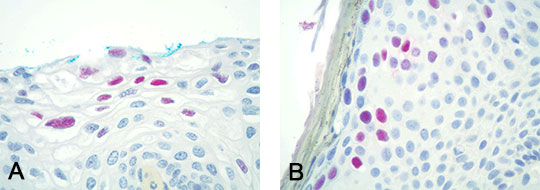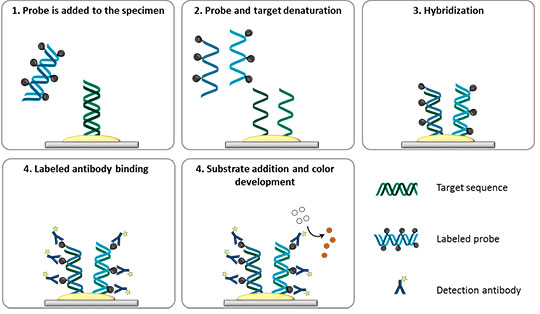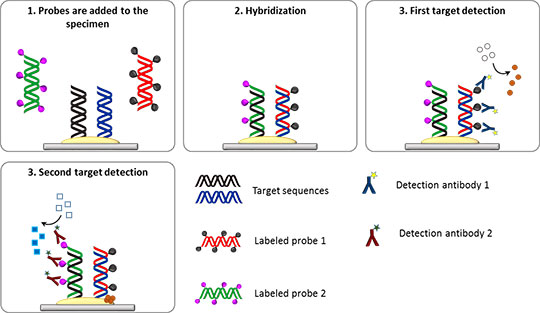The
in situ hybridization (ISH) technique is widely and routinely used. Its official birth can be dated back to 1969, when Joseph Gall and Mary Lou Pardue published a milestone paper demonstrating that radioactive copies of a ribosomal DNA sequence could be used to detect complementary DNA in the nucleus of a frog egg. Since then, advancements in molecular biology increased the versatility and the sensibility of this method, becoming a fundamental cytogenetic tool for laboratories. ISH can be used to localize and quantify DNA or RNA in nuclei, cells, tissues, or even in whole mount embryos (WMISH), thus allowing to answer a variety of questions in a range of fields, from gene expression during embryonic development to pathological genomic mutations.
|
Enzo Life Sciences developed the first non-radioactive HPV probes for in situ hybridization (ISH) in 1986. The company can therefore be considered a pioneer in the development of HPV detection systems.
|
To achieve this flexibility, based on the specific experimental needs, it is possible to choose between DNA or RNA probes, which can bear either radio-, fluorescent- or antigen-labeled (e.g. biotin, digoxigenin, etc.) bases. Radioisotope labeling of the probes is sometimes considered the most sensitive, but the application of these probes is limited by the short half-life of the isotopes as well as by safety and environmental considerations.
Enzo developed the first non-radioactive HPV probes for
in situ hybridization (ISH) 1986. As a pioneer in the development of
HPV detection systems, Enzo offers a variety of specific and sensitive probes to detect a broad spectrum of HPV types ranging from low to high risk, in fresh or FFPE tissue sections. The assay screenings (e.g.
ENZ-32882 or
ENZ-32884;
Figure 2A) allow to generically verify HPV infection, whereas the typing assays also identify the type of HPV present (e.g. ENZ-32877 , Figure 2B).

Figure 2. A. DIGX® HPV type 16/18/31/33/51 probe was used to assay cervical tissue using a Leica Bond III. Image was acquired with 40x objective. B. DIGX® HPV type 6/11 probe was used to assay cervical tissue using a Leica Bond III.
|
As a result, the use of non-radioactive probes is nowadays largely, if not exclusively, preferred. Often when talking about ISH, one refers mainly to Chromogenic
in situ hybridization (CISH), whereas the specific term FISH is used when the detection is done by fluorescence. In any case, the general working principle of the technique is the same: samples are processed so that their endogenous nucleic acids are fixed in place, but available for hybridization to labeled probes; when the probe is in contact with the target genetic material, it will specifically bind to its complementary sequence. Hybrids formed between the probes and their targets can then be visualized exploiting the different types of labeling.
Single ISH
This technique uses a unique probe to localize and quantify a specific target. Similar to immunohistochemistry, the antigen-labeled probe is recognized by a specific antibody. The latter is linked to a reporter enzyme (HRP or AP) or, in some cases, it can be recognized by a secondary reporter antibody (
Figure 1). Single ISH can be useful for example in pathology, to screen for the expression of a specific gene or to verify the presence of exogenous DNA (i.e. viral infection).

Figure 1. Workflow of a single ISH with a DNA probe
|
Dual ISH
In some cases, it is extremely helpful to get spatial and quantitative information on two (or more) genes/genomic sequences at the same time. An example can be the use of Chromosome Enumerating Probes (CEPs), targeting the pericentromeric regions of a chromosome, together with the probe actually recognizing the gene of interest (locus-specific indicator, LSI). This double staining allows the counting of the centromeres facilitating the visualization of duplications or deletions in the gene of interest. One case, among many others, in which this approach is typically used is the analysis of
Her2 gene duplication in breast cancer patients, in order to select the ones that will actually benefit from a HER2-targeted therapy.
To take another typical example from the diagnostic field, lung cancer is often associated with inversions or translocations of the
ALK gene. Probes differently labeled and targeting the 3’ and the 5’ region of the gene can be used to visualize these aberrations. In negative nuclei, the two staining will appear close to each other (often overlapping); in cancer cells, the signals will split apart as a result of the chromosome rearrangement.
In fact, the two aforementioned analyses are usually conducted by FISH, which is considered the gold standard method in the field and allows the simultaneous, direct, and sensitive detection of multiple targets. Nonetheless, a few relevant disadvantages of the techniques are increasing the interest around dual ISH via chromogenic detection in laboratories. The main FISH limitation, especially in its clinical application, is the difficulty to detect tissue morphology and tumor heterogeneity. In addition, fluorescent signals fade away relatively rapidly, making this technique less suited for long term storage and later review of the results. Finally, the observation requires the use of special equipment (i.e. a fluorescent microscope) and the technique is generally more expensive than CISH.
Consequently, chromogenic
in situ hybridization comes in handy to overcome these issues. Two options are possible concerning the protocol to obtain two distinct staining in a dual ISH. The first one is to label each of the probes with a specific hapten (e.g. biotin and digoxigenin) and proceed with the simultaneous hybridization on the specimen. The detection can then be done sequentially, one probe at time, thanks to specific antibodies linked to appropriate reporter enzymes (e.g. HRP or AP). The selection of the appropriate chromogen for each reporter will lead to the dual staining (
Figure 3).

Figure 3. Workflow of a dual ISH with DNA probes labeled with different haptens.
|
Alternatively, it is also possible to run the protocol from hybridization to detection twice in a row, once for each probe. This procedure can be helpful if the two probes that will be used carry the same hapten (
Figure 4).

Figure 4. Workflow of a dual ISH with DNA probes labeled with the same hapten. This protocol can be applied twice in a row for the double detection.
|
Besides these more classical detection methods, it is worth mentioning that for dual ISH, dinitrophenyl (DNP)-labeled probes are often used and are available with some commercial kits. In this case, the detection is done by SISH (silver
in situ hybridization). This method is similar to CISH with the difference that the end product is a silver precipitate rather than a colored one. The DNP-probe/target sequence hybrid is recognized by a primary anti-DNP antibody, bound in turn by a secondary antibody conjugated to HRP. Silver acetate, hydroquinone, and hydrogen peroxide are subsequently added and HRP catalyzes the polymerization of silver. The staining will therefore be visualized as black dots on the sample.
Given that FISH analysis is considered the gold standard, several articles can be found in the literature comparing the results obtained by FISH or CISH, with generally positive outcomes.
Enzo is a recognized global leader in providing DNA and RNA labeling technologies with several key patents on biotin- and fluorescent-labeled nucleotide probes that can be used for genomic and transcriptomic studies. We offer a range of products for
Genomics &
Pathology research needs. For a simple and efficient method for generating labeled DNA, please check out our
Nick translation DNA labeling kit as well as a list of our
SEEBRIGHT® fluorescent dye-dUTPs and our
Allylamine-dUTP. If you want to learn more about different type of probes, or you need tips for your ISH/FISH, do not miss our TechNotes on these topics: “
What are the Differences Between DNA and RNA Probes?”, “
Tips for Successful FISH” and “
10 Tips for Optimizing In Situ Hybridization (ISH)”. For all questions and concerns regarding any of our products, our
Technical Support Team is here to assist.













